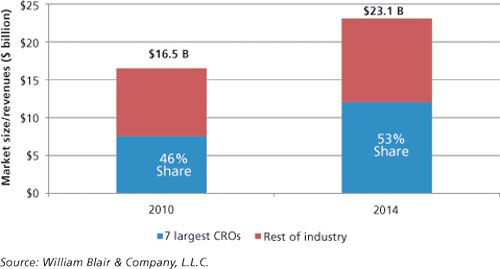More Evidence that Size Matters
Big service providers get bigger faster thanks to Big Pharma.
Size has proven to be a major competitive advantage in the clinical contract research organization (CRO) industry, and if that experience is any guide, it presages how the dose CMO industry will evolve as well.
The seven largest clinical CROs, six of which are public companies today, accounted for 52% of bio/pharmaceutical industry spending on CRO services in 2014, up from 45% in 2010 (Figure 1) (1). Over that period, the market for clinical CRO services grew almost 40%, to $23 billion, but the top seven CROs collectively grew nearly 60%. They occupy an increasingly dominant position in a rapidly growing market.

The big CROs have extended their market share lead thanks in large part to their ability to secure preferred provider status with the 25 largest bio/pharmaceutical companies. Those global bio/pharma companies account for 60% of the industry’s R&D spending, and an even larger share of spending on complex, expensive Phase 2B and Phase 3 clinical trials. Most large bio/pharma companies have embraced strategic relationships that involve transferring substantial portions of their clinical research operations to just two clinical CROs. These relationships typically incorporate trial monitoring and data management activities, of which are both labor- and information technology-intensive; and may extend to other activities such as medical writing and medical affairs.
The global bio/pharma companies entrust the largest CROs with those critical operations primarily because of the CROs’ relatively large size and scope of capabilities:
They operate global networks that enable them to run multinational clinical trials with sites in dozens of countries
They have the financial strength and infrastructure to absorb hundreds of staff transferred to their payrolls from the bio/pharmaceutical companies, and to take over a large number of ongoing studies in an orderly fashion.
Further, once they have secured these relationships, the large CROs have proven adept at maintaining them, using their operating skills to reduce the costs and time needed to execute complex clinical trials. In particular, they use their operating experience to ensure the trial protocols can be readily implemented; and they are making key investments in information technology to enable rapid data collection and analysis and use that data for critical activities like site selection and patient recruitment.
The scale of these strategic relationships can be massive: Parexel generated more than $300 million in 2014 from its relationship with Pfizer, and several other CROs receive nearly 50% of their billions in revenues from just five strategic clients. Such dependence on a few clients can be risky of course, but the tight integration with the client means that the switching costs for the client can be high.
Big pharma plays favorites
The preference for working with a small number of strategic suppliers appears to extend into the contract dose manufacturing market as well. Research by PharmSource indicates that while global bio/pharma companies seldom outsource the drug product manufacture for their new molecular entities (NMEs), when they do there are only a few select CMOs they appear willing to work with (2).
During the 2010–2014 period, global bio/pharma companies received 88 NME approvals, of which just 20 (22%) were outsourced to CMOs, including CMOs used as second sources of supply. Eighty percent of those outsourced NMEs went to only five CMOs. The same five CMOs also got the lion’s share of opportunities for all global bio/pharma new drug application (NDA) approvals for which drug product manufacture was outsourced.
The concentration of CMOs serving global bio/pharma companies stands in contrast to the industry overall, as our analysis shows that at least 146 CMOs have benefitted from at least one NDA approval in the past 10 years. The CMO Scorecard: Outsourcing of NDA Approvals and CMO Performance shows, however, that the CMO industry is actually more consolidated than it may appear from the outside (see Figure 2).

Like their counterparts in the clinical CRO space, the five CMOs receiving the bulk of global biopharma NME manufacturing opportunities are among the largest in the industry in terms of revenues, are financially strong, and have good compliance records, so they represent secure sources of supply. Further, those companies continue to invest in their capabilities and capacity to grow their business and gain even more market share.
Global bio/pharma companies have shown themselves willing to embrace strategic supplier relationships with service organizations that have the scale and scope to meet a broad range of their requirements. Only a few CMOs and CDMOs, however, have demonstrated the willingness to invest in the vision of a world-class development and manufacturing services provider. The evidence suggests that the opportunities may be out there if the industry is willing to step up to them.
References
1. William Blair & Company, L.L.C.
2. PharmSource, Trend Report, CMO Scorecard: Outsourcing of NDA Approvals and CMO Performance (PharmSource, February 2015).
All figures are courtesy of the author.
Article DetailsPharmaceutical Technology
Vol. 39, Issue 4
Pages: 80-81
Citation: When referring to this article, please cite it as J. Miller, "More Evidence that Size Matters," Pharmaceutical Technology 39 (4) 2015.

Pharmaceutical Tariffs Are Imminent: How Industry is Bracing for Impact
April 16th 2025On April 14, 2025, the Trump Administration launched a national security-driven investigation into pharmaceuticals, a move that will likely result in tariffs being placed on pharmaceutical drugs, ingredients, and other components that are imported from outside of the United States.